NCERT Solutions for Class 4 Maths Chapter-11
This page consists of NCERT Solutions for Chapter 11 Tables And Shares prepared by Maths experts. All the questions asked in Tables And Shares of the NCERT textbook are solved with relevant methods recommended by CBSE.
A brief explanation of Chapter 11 Tables And Shares
Chapter 11 Tables And Shares tells you all about the basics of multiplication and division in this chapter students are going to learn concepts and its application used while doing basics maths applications like how to multiply and what is the use of division. You are going to learn the methods used for division. The most important thing which students must do in this chapter before attempting the questions given in the exercise of the NCERT textbook tries to remember tables from 1 to 10, while remembering the table from 1 to 10 there are lots of shortcuts which tutors explain in the class use that shortcut and build your own fundaments in maths.
Find a free pdf of NCERT Solutions for Chapter 11 Tables And Shares
Q1: What are the ways in which the sunflower and marigold are planted? 18 = ×
So, there are rows with plants each. 18 = ×
So, there are rows with plants each.
Answer:
18 = 2 × 9 So there are 2 rows with 9 plants each.
18 = 3 × 6 So there are 3 rows with 6 plants each.
Q2: Jars in the Shelf Bheema made a shelf for 30 jars. This is a long shelf with two rows. Each row has the same number of jars. Can you think of other ways to make a shelf to keep 30 jars?
- Draw a shelf. Show how many jars you will keep in each row. How many rows are there?
Have your friends drawn it in different ways?

Answer:
Yes, we can make a shelf with 3 rows to keep 30 jars.
Total number of jars = 30 Number of rows = 3 Number of jars in each row = 30 ÷ 3 = 10
There are 10 jars in each row of the shelf.
Q3: Help Bunty to make the table of 7, using tables of 4 and 3.
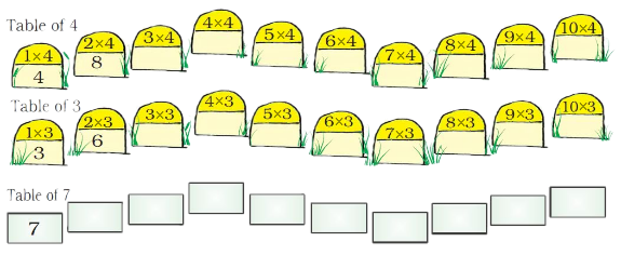
Answer:
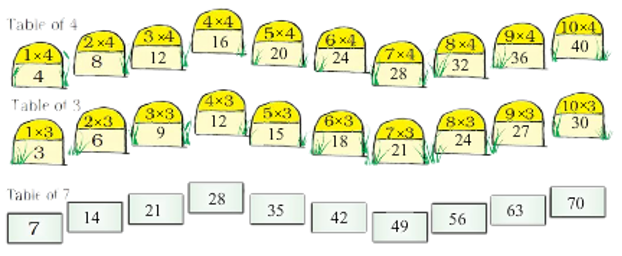
Q4: Which two tables will you use for writing the table of 12?
Answer:
We will use the tables of 5 and 7 for writing the table of 12.



Q5:
| How many legs? | 4 | 8 | 12 | |||||
| How many cats? | 1 | 2 |
So 28 legs mean cats.
Answer:
Number of legs of 1 cat = 1 × 4 = 4
Number of legs of 2 cats = 2 × 4 = 8
Number of legs of 3 cats = 3 × 4 = 12
Continuing in the same manner, we can easily fill the given table.
| How many legs? | 4 | 8 | 12 | 16 | 20 | 24 | 28 | 32 |
| How many cats? | 1 | 2 | 3 | 4 | 5 | 6 | 7 | 8 |
From the table, we can see that 7 cats have 28 legs.
Q6: Billo has kept his chickens in a box. He counted 28 legs. How many chickens are there?
Answer:
A chicken has 2 legs. So, if there are total 28 legs then the number of chickens kept in the box
= 28 ÷ 2 = 14
Thus, 14 chickens are there in the box.
Q7: Leela has not gone to school for 21 days. For how many weeks was she away from school?
Answer:
Number of days Leela did not go to school = 21 days.
A week has 7 days so the number of weeks Leela did not go to school
= 21 ÷ 7 = 3

Thus, Leela did not go to school for 3 weeks.
Q8: A frog jumps 3 steps at a time starting from 0.
- Count the jumps he takes to reach 27. So, he has taken 27 ÷ 3 = jumps
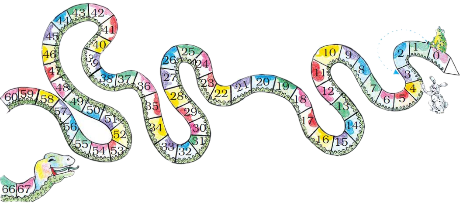
He has taken jumps, if he is at 36.
- If he is at 42, he has taken jumps. Starting from 0, a rabbit jumps 5 steps at a time.
- In how many jumps does he reach 25?
- He reaches after taking 8 jumps.
- He needs jumps to reach 55.
Answer:
Number of jumps taken by the frog to cover 3 steps = 1
Number of jumps taken by the frog to cover 27 steps = 27 ÷ 3 = 9 So, he has taken 27 ÷ 3 = 9 jumps.
Number of jumps taken by the frog to cover 3 steps = 1
Number of jumps taken by the frog to cover 36 steps = 36 ÷ 3 = 12 He has taken 12 jumps, if he is at 36.
Number of jumps taken by the frog to cover 3 steps = 1
Number of jumps taken by the frog to cover 42 steps = 42 ÷ 3 = 14 If he is at 42, he has taken 14 jumps.
Number of jumps taken by the rabbit to cover 5 steps = 1 Number of jumps taken by the frog to cover 25 steps = 25 ÷ 5 = 5 Thus, the rabbit will reach 25 in 5 jumps.
Number of steps covered in 1 jump = 5
Number of steps covered in 8 jumps = 5 × 8 = 40 He reaches 40 after taking 8 jumps.
Number of jumps taken by the rabbit to cover 5 steps = 1
Number of jumps taken by the frog to cover 55 steps = 55 ÷ 5 = 11 He needs 11 jumps to reach 55.
Q9: Practice Time (1) 28 ÷ 2 =
(2) 56 ÷ 7 =
(3) 48 ÷ 4 =
(4) 66 ÷ 6 =
(5) 96 ÷ 8 =
(6) 110 ÷ 10 =
Answer:
(1)

(2)

(3)

(4)

(5)

(6)

Q10: He took 28 shells for one necklace. 112 − 28 = 84 Now he was left with 84 shells. Again he took 28 more shells for the second necklace.
- How many shells are left now? Then he took shells for the third necklace.
- So he was left with shells.
- How many necklaces can Dhruv make from 112 shells?
- Are the shells enough for making necklaces for all his friends?
Answer:
After making the first necklace, Dhruv was left with 84 shells. Number of shells used for the second necklace = 28
Number of shells left with Dhruv = 84 − 28 = 56
Working: 84-28=56Thus, Dhruv was left with 56 shells after making the second necklace. Dhruv took 28 more shells for making the third necklace.
Number of shells left with Dhruv after making third necklace = 56 − 28 = 28
Dhruv made a necklace of 28 shells for each of his three friends. After making the necklaces for his friends, he was left with 28 shells.
So, he could make one more necklace with the remaining shells. Thus, Dhruv could make a total of 4 necklaces with 112 shells.
Yes, the number of shells were enough for making necklaces for all the friends. After making 3 necklaces for his friends, 28 shells were still left with Dhruv.
Q11: Kannu made a necklace of 17 sea-shells. How many such necklaces can be made using 100 sea- shells?
Answer:
Kannu made a necklace of 17 sea-shells.
Number of necklace that can be made from 100 sea-shells = 100 / 17 = 6
So, 6 necklaces can be made from 102 sea- shells. Thus 2 more sea-shell is required to make 6 necklaces.
Q12: One carton can hold 85 soap bars. Shally wants to pack 338 soap bars. How many cartons does she need for packing all of them?
Answer:
Soap bars 1 carton can hold = 85
Soap bars 2 cartons can hold = 2 × 85 = 170
Soap bars 3 cartons can hold = 3 × 85 = 255
Soap bars 4 cartons can hold = 4 × 85 = 340
340 soaps can be accomodated in 4 cartons. Thus, 4 cartons will be needed to pack 338 soap bars.
Q13: Manpreet wants 1500 sacks of cement for making a house. A truck carries 250 sacks at a time. How many trips will the truck make?
A driver charges Rs 500 for a trip. How much will Manpreet pay the driver for all the trips?
Answer:
Number of sacks a truck can carry at a time = 250
In 2 trips number of sack carried = 250 × 2 = 500
In 3 trips number of sack carried = 250 × 3 = 750
In 4 trips number of sack carried = 250 × 4 = 1000
In 5 trips number of sack carried = 250 × 5 = 1250
In 6 trips number of sack carried = 250 × 6 = 1500
Thus, 6 trips are required to carry 1500 sacks.
Q14: Gangu’s Sweets Gangu is making sweets for Id. He has made a tray of 80 laddoos.
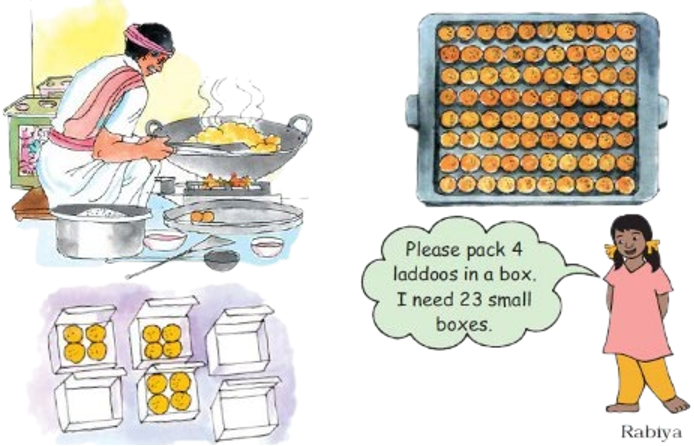
Are the sweets in the tray enough to pack 23 small boxes?
- How many more sweets are needed?
- Gangu also has a bigger box in which he packs 12 laddoos.
How many boxes does he need for packing 60 laddoos?
Answer:
Number of laddoos in a box = 4
Number of laddoos in 23 boxes = 4x 23 = 92. Total number of laddoos in the tray = 80
No, the laddoos are not enough to pack in the boxes. There are 80 laddoos and 92 laddoos are required. Thus, Gangu is falling short of 12 laddoos.
Q15: Practice Time : Neelu brought 15 storybooks to her class. Today 45 students are present. How many children will need to share one book?
Answer:
Neelu brought 15 storybooks to her class 45 students are present in the class
Total number of children sharing one book = 45 ÷ 15 = 3 Thus, 3 children need to share one book.
Q16: Practice Time: A family of 8 people needs 60 kg wheat for a month. How much wheat does this family need for a week?
Answer:
In one month a family requires 60kg of wheat. In a month, there are 4 weeks.
So, the quantity of wheat required in one week by the family= 60 ÷ 4 kg = 15 kg

Thus, the family needs 15 kg of wheat in one week.
Q18: Practice Time: You have to distribute 72 tomatoes equally in 3 baskets. How many tomatoes will there be in each?
Answer:
If 72 tomatoes needed to be equally distributed in three baskets then each basket will contain
- = 72 ÷ 3
- = 24.
- working:

Thus, 24 tomatoes will be there in each basket.
Q19: Practice Time There are 350 bricks in a hand-cart. Binod found the weight of a brick to be 2 kg. What will be the weight of all the bricks?
Answer:
If the weight of 1 brick is 2 kg then the weight of 350 bricks = 2 × 350 kg = 700 kg Thus, the weight of all the bricks is 700kg.
Q20: Try Doing These
(a) 65 ÷ 5
(b) 84 ÷ 2
(c) 69 ÷ 3
(d) 90 ÷ 6
(e) 72 ÷ 4
(f) 91 ÷ 8
(g) 232 ÷ 2
(h) 428 ÷ 2
Answer:
(a)

(b)

(c)

(d)

(e)

(f)

(g)

(h)

Q21: Meera made 204 candles to sell in the market. She makes packets of 6. How many packets will she make? If she packs them in packets of 12, then how many packets will she make?
Answer:
Number of candles made by Meera = 204.
Number of candles in each packet = 6
Total number of packets of candles = 204 ÷ 6 = 34.
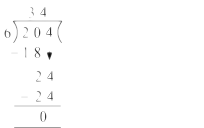
Thus, 34 packets are required for 204 candles.
If Meera packs 12 candles in each packet then number of packets required for 204 candles
= 204÷ 12 = 17
Working:

Thus, Meera will be needing 17 packets to pack 204 candles with each packet containing 12 candles.
Q22: On Sports Day, 161 children are in the school playground. They are standing in 7 equal rows. How many children are there in each row?
Answer:
Students present in the playground = 161 Number of rows = 7
If the number of students are equal in each row then the number of students in each row
= 161 ÷ 7 = 23
Working:

Thus, In each row there are 23 students.
Q23:

There are 8 packets of rakhis. Each packet has 6 rakhis in it. Your question: Answer: Number of Rakhis in each packet = 6
Total number of packets = 8x6 = 46.
Thus, there are a total of 46 rakhis in 8 packets. My question: How many rakhis are there in total? 24:
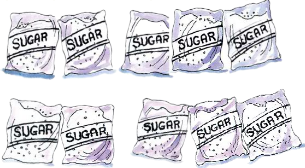
There are 10 packets of sugar. Saurabh paid 110 rupees for all the packets. Your question:
What is the cost of 1 packet of sugar?
Q25:
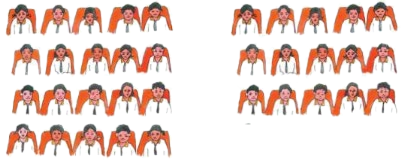
There are 35 students in 7 rows. Each row has the same number of students. Your question:
Answer: Total number of students = 35
Total number of row = 7
If the number of students are equal in all the rows then each row has
= 35÷7 = 7 students.
Thus, there are 7 students in each row. How many students are there in each row?
Q26: Hari, Seema, Chinku and Lakshmi are going to Guwahati. The cost of one rail ticket is Rs 62.
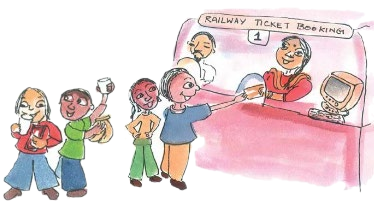
Your question:
Answer:
Cost of one ticket = Rs 62 Number of people = 4
Total cost of the ticket = Rs 62x4 = Rs 248 What is the total cost of the rail tickets?
Q27: One metre of cloth costs Rs 20. Lalbiak bought some cloth and paid Rs 140.
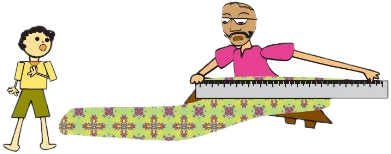
Your question:
Answer:
Total amount paid by Lalbiak = Rs 140 Cost of 1 metre of cloth = Rs 20
Total number of metres of cloth bought = Rs 140 ÷ 20 = Rs 7 Thus, Lalbaik bought 7 metres of clothes in Rs 140.
How many metres of cloth did Lalbiak buy?